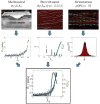A theoretical and non-destructive experimental approach for direct inclusion of measured collagen orientation and recruitment into mechanical models of the artery wall
- PMID: 22305290
- PMCID: PMC5962021
- DOI: 10.1016/j.jbiomech.2011.11.016
A theoretical and non-destructive experimental approach for direct inclusion of measured collagen orientation and recruitment into mechanical models of the artery wall
Abstract
Gradual collagen recruitment has been hypothesized as the underlying mechanism for the mechanical stiffening with increasing stress in arteries. In this work, we investigated this hypothesis in eight rabbit carotid arteries by directly measuring the distribution of collagen recruitment stretch under increasing circumferential loading using a custom uniaxial (UA) extension device combined with a multi-photon microscope (MPM). This approach allowed simultaneous mechanical testing and imaging of collagen fibers without traditional destructive fixation methods. Fiber recruitment was quantified from 3D rendered MPM images, and fiber orientation was measured in projected stacks of images. Collagen recruitment was observed to initiate at a finite strain, corresponding to a sharp increase in the measured mechanical stiffness, confirming the previous hypothesis and motivating the development of a new constitutive model to capture this response. Previous constitutive equations for the arterial wall have modeled the collagen contribution with either abrupt recruitment at zero strain, abrupt recruitment at finite strain or as gradual recruitment beginning at infinitesimal strain. Based on our experimental data, a new combined constitutive model was presented in which fiber recruitment begins at a finite strain with activation stretch represented by a probability distribution function. By directly including this recruitment data, the collagen contribution was modeled using a simple Neo-Hookean equation. As a result, only two phenomenological material constants were required from the fit to the stress stretch data. Three other models for the arterial wall were then compared with these results. The approach taken here was successful in combining stress-strain analysis with simultaneous microstructural imaging of collagen recruitment and orientation, providing a new approach by which underlying fiber architecture may be quantified and included in constitutive equations.
Copyright © 2011 Elsevier Ltd. All rights reserved.
Figures










References
-
- Barra J, Armentano R, Levenson J, Fischer E, Pichel R, Simon A. Assessment of smooth muscle contribution to descending thoracic aorta elastic mechanics in conscious dogs. Circulation Research. 1993;73:1040–1050. - PubMed
-
- Bischoff JE, Arruda EM, Grosh K. A rheological network model for the continuum anisotropic and viscoelastic behavior of soft tissue. Biomechanics and Modeling in Mechanobiology. 2004;3:56–65. - PubMed
-
- Burton A. Relation of structure to function of the tissues of the wall of blood vessels. Physiol Rev. 1954;34:619–642. - PubMed
-
- Chaudhuri B, Kundu P, Sarkar N. Detection and gradation of oriented texture. Patt Recog Lett. 1993;14:147–153.
Publication types
MeSH terms
Substances
Grants and funding
LinkOut - more resources
Full Text Sources
Research Materials

